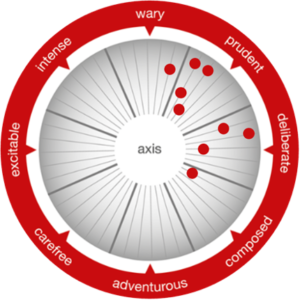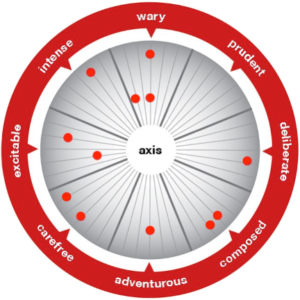This month, PCL’s Dr. Simon Toms reviews General Stanley McChrystal’s book, ‘Team of Teams’
When General Stanley McChrystal took command of the Joint Special Operations Task Force in Iraq in 2003, he quickly realized that conventional military tactics were failing. The United States and coalition forces had entered Iraq and quickly deposed Saddam Hussein, yet attacks from insurgents, most notably Al Qaeda, were growing in quantity and severity. The allied forces had a huge advantage in numbers, equipment, and training – but none of the enemy’s speed and flexibility. General McChrystal details these challenges, and how they were overcome, in his 2015 New York Times bestseller ‘Team of Teams’.
At PCL, our work as personality psychologists not only focusses on the key characteristics that inform decision making and predict behaviour at an individual level but extends to team composition and even organisational culture. As the book’s title suggests, our work is highly relevant given the formation and functioning of teams was integral to meeting the challenges posed by tech-savvy insurgents. Whilst General McChrystal’s focus was overcoming various problems in a military context, the lessons he learned are relevant to any current organisation. They begin by re-evaluating deeply rooted management practices that emerged in the late 19th century, perhaps most notably with Frederik Winslow Taylor.
The Emergence of Scientific Management
Born in 1856 to a wealthy Quaker family in Philadelphia, Frederik Taylor had planned to attend Harvard and follow in his father’s footsteps as a lawyer. However, failing eyesight led him down a surprisingly different path as an apprentice patternmaker and machinist. Subsequent years witnessed Taylor’s meteoritic rise through the ranks, yet during this time, Taylor continually lamented the lack of efficiency he observed from workers on the shop floor.
Before Taylor, a workman’s methods were part of his art, borne from lengthy apprenticeships and honed through years of experience. Tips of varying quality were occasionally and inconsistently communicated through word of mouth within secretive trade unions. Taylor considered these idiosyncratic and guarded processes a major obstacle to efficiency. Through relentless observation and testing to establish ‘best practice’, Taylor reduced previously experience-demanding tasks into prescriptive and simplified steps that far less practiced workers could complete. Output soared whilst costs and time plummeted, yet these improvements were not primarily driven by technology but from a devout commitment to optimisation. Unveiling these advancements at the 1900 Paris Exposition cemented Taylor’s reputation as an internationally renowned giant of industry and the father of scientific management.
In the decades following Taylor’s death in 1915, criticisms of his approach grew. His perception of workers has attracted particular challenge, fuelled by his tendency to conceive of them as mechanistic entities to be manipulated. In one instance, he reportedly told workers, “I have you for your strength and mechanical ability. We have other men paid for thinking.” In his influential book ‘The Principles of Scientific Management’, Taylor mocked labourers’ syntax and described them as “mentally sluggish.” Whilst insulting, this negative characterisation stemmed from how Taylor perceived their labour. The work was complicated, but could ultimately be compartmentalised, standardised, and predicted. The goal of top-down management advocated by Taylor was to therefore maximise efficiency by identifying and enforcing best practice. This leads to a core lesson of Team of Teams: the differentiation between complicated and complex problems.
Is a Problem Complicated or Complex?
Solving complicated problems in the most effective way possible was the key ambition of scientific management. Complicated things may have many moving parts that might appear confusing, but they can be broken down into a series of neat and tidy deterministic relationships. Perhaps the most famous example is Henry Ford’s pioneering assembly line. At the turn of the 20th century, building a car would take skilled workmen several days. Yet in 1913 by applying Taylor’s principles of scientific management and dividing the assembly process into a set of specialised roles, Ford was able to compress the manufacturing process down to just 93 minutes.
Complexity differs significantly. Complicated problems may require great effort but can ultimately yield to prediction in a manner that complex problems cannot. Complexity occurs when the number of interactions between components dramatically increases to a point where accurate prediction becomes significantly more difficult, and often impossible. The reality is that small things in a complex system may have no effect or a massive one, and it is virtually impossible to know which will turn out to be the case. Complexity means that, despite our increased abilities to track and measure, the world has become, in many ways, far less predictable.
Complexity underpinned many of the challenges facing General McChrystal and his Task Force, and the top-down hierarchical structure of the military meant that those facing these challenges often lacked the flexibility to adjust quickly enough. In a break from tradition, a strategic rethink concluded that adaptability, not efficiency, needed to become the Task Force’s central competency. To counteract the pre-existing command-like superstructure in favour of requisite organic fluidity, efforts were made to develop a ‘team of teams.’ This coincided with the goals of increasing autonomy, building open communication channels, and encouraging greater ownership of decisions. This brings us to our work on personality and how it can significantly influence the effectiveness of teams.
Teams Need to Adapt to Complex Problems, but How?
Put simply, teams can solve problems that one person cannot, and this increased potential is predicated on difference. The best goalkeeper in the world will improve any team they join, but cloning them for the remaining ten positions will likely reduce the team’s effectiveness and hamper their ability to react and adapt to the ebbs and flows of a match. This is why diversity and adaptability are heavily intertwined. If managed effectively, a team’s ability to make decisions and succeed in a complex and unpredictable environment increases when they can identify and consider a variety of different potential solutions.
One way to understand and assess how people differ is through personality psychology. Personality is a hugely influential and well-evidenced topic defined as “…psychological qualities that contribute to an individual’s enduring and distinctive patterns of feeling, thinking and behaving” (Cervone & Pervin, 2010; p. 8). Personality is not the sole influence on your behaviours, but when you are required to make thousands of conscious and unconscious decisions daily, its impact becomes impossible to ignore. One popular approach to measuring aspects of personality highly influential to decision making is the Risk Type Compass.
Informed by neuroscience and personality psychology, the Risk Type Compass (RTC) identifies the personal biases that come into play whenever we make decisions. Two independent systems contribute to this, Emotion (how anxious or fearlessly risk-embracing we are) and Cognition (the degree to which we can tolerate uncertainty or need to make sense of everything). The RTC accurately measures each system and uses this information to assign individuals a ‘dot’ within one of eight ‘Risk Types’ or an Axial group. Each Risk Type encompasses distinctive characteristics that have sizeable ramifications for how we think and behave. Research not only demonstrates how these individual differences in risk instinct significantly influence our lives, but how they are compounded within the dynamics of group thinking. This is why team composition is key.


Temperamentally Homogenous (left) and Diverse (right) team
The graphics above illustrate two separate teams. The team displayed on the left contains four different Risk Types, but all are adjacent to one another and clustered in a single quadrant. In contrast, the team on the right are far more evenly spread, demonstrating that they possess a greater diversity of risk-relevant personality characteristics. Both teams may be highly functional but would benefit from an awareness of the innate tendencies of their team and the individuals that constitute it. This will be particularly true of more homogenous teams.
The hazards of a highly homogenous team were perhaps most famously observed in the 1960s by Professor James A.F. Stoner, who coined the term ‘risky shift’ after conducting a series of experiments demonstrating that group discussions often led to riskier decisions than those made by individuals. However, subsequent refinement noted that risky shift is not a universal phenomenon, as research indicates that some groups may tend towards more cautious decisions – termed ‘cautious shift’. These seemingly contradictory conclusions can be explained when the innate tendencies of a group are measured effectively: homogenously ‘risk averse’ groups will typically favour more cautious decisions over homogenously ‘risk seeking’ groups. Insight like this can prove invaluable when creating or working with teams, but pursuit of a diverse team may be hampered by the profession the team works in.



Risk Type Breakdown of Recruiters (left) Legal Professionals (centre) and Air Traffic Controllers (right)
The three examples above illustrate an important finding in the RTC research literature: personality strongly predicts people’s career choices. Personality is an important factor in how people choose their jobs (attraction), whether people are recruited to these jobs (selection) and whether people remain in these jobs (attrition). This means that, to varying degrees, many industries may lack the diversity of personality present in the wider population due to the consequences of attraction, selection, and attrition. This is an important point to consider when building and developing teams, as attempting to form more varied group compositions in some professions may prove more challenging.
To conclude
Huge social and technological changes have resulted in a world that is more complex than ever. Approaches to complicated problems prioritising standardisation and efficiency can prove ineffectual when applied to complex problems. In response, focus has shifted to maximising adaptability, which is best achieved through diverse and well-managed teams. Understanding personality at both an individual and group level is vital to harnessing the diversity required to maximise adaptability and succeed. Effective measurement is a key requisite that psychometrics like the Risk Type Compass can fulfil.